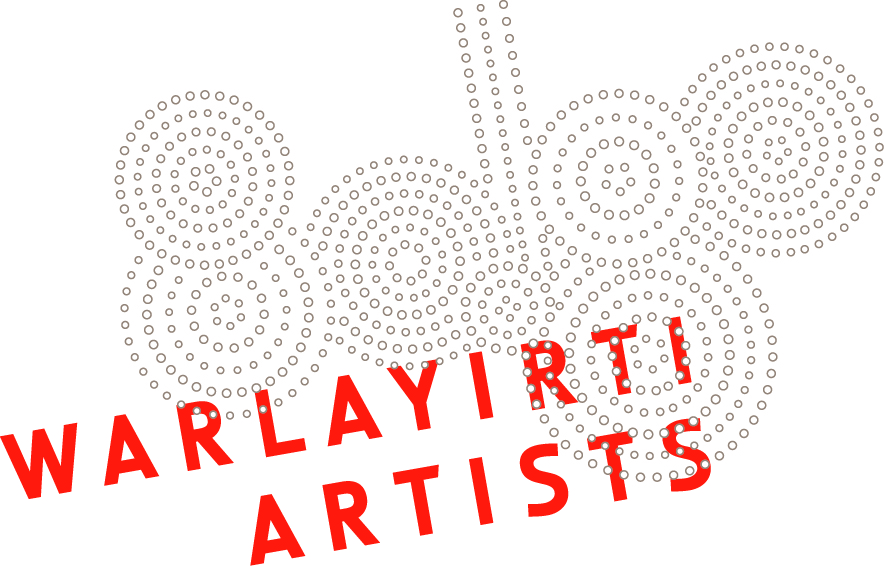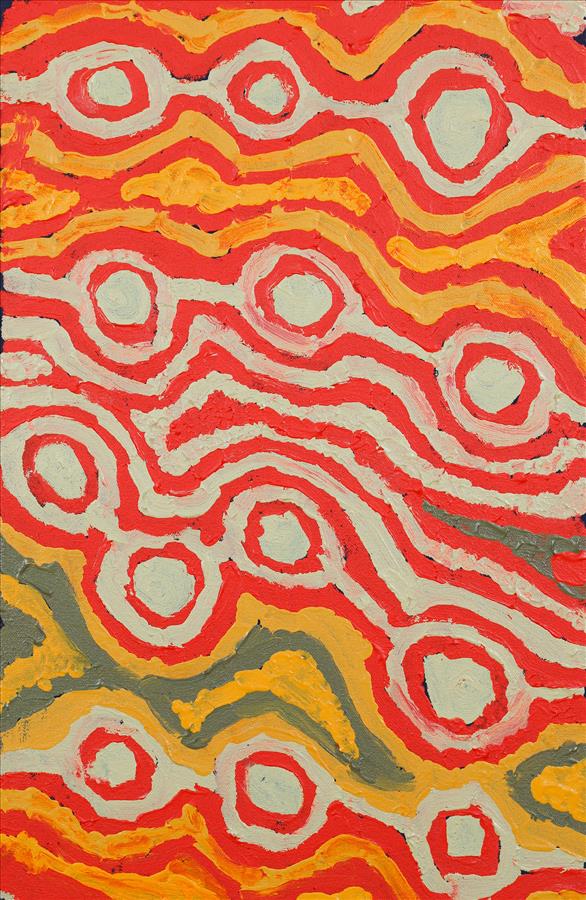Wangkartu by HELICOPTER (Joey Tjungurrayi)
Artist : HELICOPTER (Joey Tjungurrayi)
Title : Wangkartu
Size/Medium : 457 x 305mm: acrylic on canvas Painting
Biography :
Helicopter Joey Tjungurrayi is widely recognised as one of Warlayirti Artists’ leading painters and a respected ambassador for the Art Centre. He has been painting with Warlayirti Artists since the early 1990s.
Born at Nyinmi, west of Kiwirrkurra in Western Australia, Helicopter was raised in a traditional nomadic lifestyle. From childhood, he learned to locate water sources and hunt for bush food—knowledge deeply rooted in his relationship to Country and foundational to his art practice. The time he spent travelling through Country as a young boy has had a profound and lasting influence on his creative process.
As James Cowan wrote in Balgo: New Directions (1999), speaking of the Balgo artists:
“…their work is grounded in a quintessential act of reverie.”
Helicopter’s work exemplifies this. His quiet dedication to painting is a gesture of deep reverence for his land and culture.
“My father got [my spirit] from [Nyakin], and my mother too…
They were just taking me around them Countries, my mother and father.
They took me everywhere.”
(Carty, J. — Yiwarra Kuju, The Canning Stock Route, 2010)
In 1957, while walking on Country with his family, Helicopter became seriously ill. A helicopter involved in mining exploration flew him to the Old Balgo Mission for medical treatment—an extraordinary event, and the first time many people in the region had seen such a machine. The moment left its mark and earned him the name by which he is known today.
During his time at the mission, Helicopter worked on various tasks: drilling for water, cutting timber for fences, fixing windmills, and travelling across the region to collect supplies from Kimberley ports. It was also at the Balgo mission that he met and married Lucy Napanangka Yukenbarri. Together they raised six children, including two from Napanangka’s previous marriage. Their partnership endured until her passing in 2003. Two of their daughters, Christine Yukenbarri and Imelda (Yukenbarri) Gugaman, are now accomplished artists in their own right.
In the early 1990s, Helicopter began painting alongside Napanangka, initially without seeking personal recognition. By 1994, he started developing his own unique style. His works often radiate from a central tjurnu (soakwater) and are built through a rhythmic, methodical application of thick paint. With a brush dipped in memory, he dots and drags paint across the linen in long parallel lines, evoking the tali (sandhills) that dominate his parents’ Country.
He is often seen on the veranda of the art centre, facing south toward his homelands. Between brushstrokes, his gaze drifts toward the desert as if scanning the horizon for the distant shimmer of tjurnu and tali. When asked about his painting, he gestures gently toward the land: “Good country, my country.”
Helicopter’s work began gaining wider recognition in 1999, when he held his first solo exhibition and was selected as a finalist for both the NATSIAA and Alice Prize. He was again a NATSIAA finalist in 2002. Over the years, he has had six solo exhibitions—two of them alongside his late wife—and has participated in many significant group shows. His work has been exhibited across Australia and internationally, including in London, Amsterdam, and Tokyo. In 2010, as part of the Motika project, he led a team of Warlayirti artists to Tokyo, where they painted a brand-new Audi.
In recent years, Helicopter developed cataracts in his right eye, which severely affected his vision. Despite this, his commitment to painting never wavered. Each morning, he walked to the art centre with his loyal pack of dogs, felt his way to his seat, and began to paint—his hand moving across the canvas as though singing the lines into being, his memory guiding his palette.
In late 2015, Helicopter underwent eye surgery, which restored much of his sight. With improved vision came a renewed confidence and experimentation in his work, including stronger contrasts and playful colour relationships.
Helicopter is a Maparn (traditional healer), a Senior Lawman, and a ceremonial singer. In 2022, he was named a Western Australian Cultural Living Treasure in recognition of his outstanding contribution to art and culture.
In 2023, he suffered a serious fall and broke his arm. Remarkably, even during his hospital stay and rehabilitation, he continued to create artwork. He has since returned to Balgo and continues to paint with the same strength and clarity that has defined his long and respected career.
About this painting :
Helicopter has depicted his traditional Country, located far to the southwest of Balgo in the heart of the Great Sandy Desert. This land lies near Nyinmi and is known as Wangkartu — named after the tjurrnu (soakwater) that once sustained him as a young man, travelling and hunting with his family across the desert.
The painting is marked by long, flowing parallel lines that represent the tali — the sand dunes — that shape and define this vast and powerful landscape. Through these lines, Helicopter evokes both memory and geography, mapping the contours of a life lived close to Country.
| Weight | 0.8 kg |
|---|





